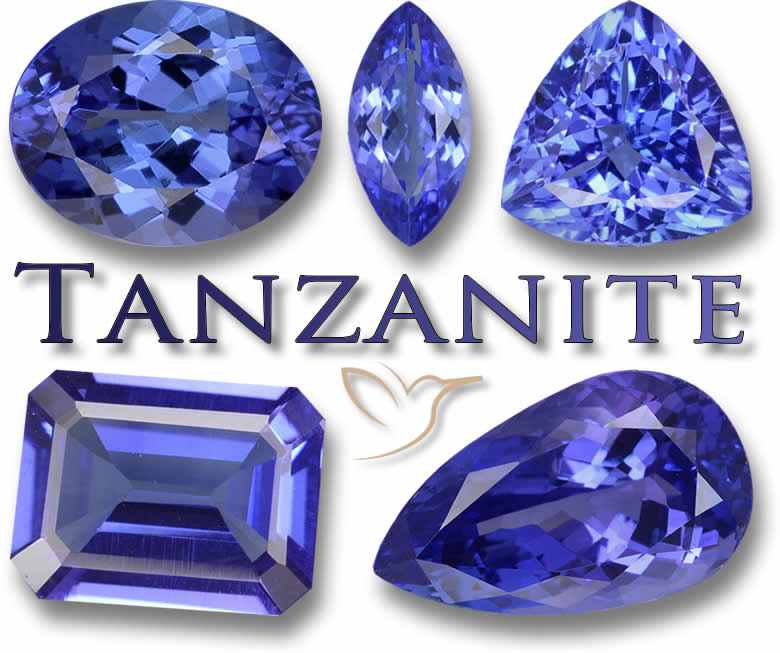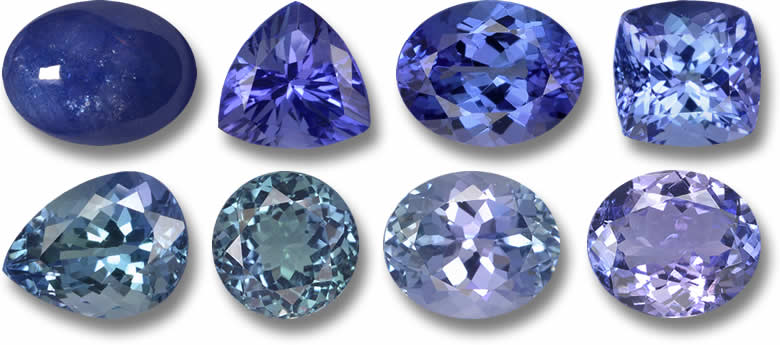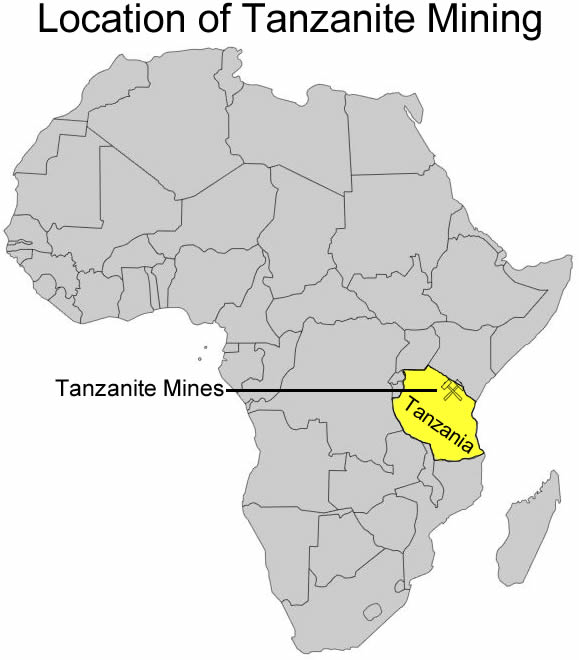Tanzanite Gemstone Information

Introduction
Imagine being the person who discovered a gemstone rarer than diamonds. What a story that would make, and that's exactly the tale of Maasai tribesman Ali Juuyawatu, who found tanzanite in the hills of northern Tanzania near the majestic Mount Kilimanjaro.
As with many stories about finding treasure, there's a touch of mystery surrounding tanzanite's discovery. The most widely accepted version is that Maasai herdsmen were tending their cattle in the Tanzanian hills shortly after a fire scorched the grasslands in 1967. Brown stones and rocks dotted the landscape as usual, but on this day, the herdsmen spotted a blue glow in some of the rocks. They brought these to local amateur gemologist Manuel de Sousa, who initially believed he had sapphires. After proper identification, it turned out they were rare zoisite crystals.
When Henry Platt, the President of Tiffany's, first saw the gemstones (tanzanite), he declared it to be "the most beautiful gemstone to be discovered in 2000 years".
However, he had an issue with the name "Blue Zoisite," feeling it wouldn't appeal to buyers. So, he renamed it Tanzanite after its country of origin and directed his company to promote this stunning new gemstone.
Meanwhile, Manuel de Sousa had staked mining claims in the discovery area, expecting wealth and fame. Sadly, he couldn't secure the mines, and estimates suggest 80% of the gemstones were stolen before sale. He died in 1969 under mysterious circumstances in a car crash. Since then, the mines have faced natural disasters, gang looting, and nationalization, but recent stability has ensured a steady supply.
Things become a bit unclear, though, when we look at U.S. Gemological Survey records, which note a blue zoisite crystal identified by Dr. William Pecora in 1959. Then there's Jumanne Ngoma, awarded a certificate and $22 prize by Tanzania's government in 1984 for being the official discoverer. Ngoma claims President Julius Nyerere coined the name Tanzanite!
All these questions and twists surround a gemstone discovered just over 50 years ago.
Tanzanite Colors

Tanzanite is renowned as a blue gemstone, but it's far more versatile. Its hues range from light, almost sky blue to deep midnight blue. Mix in flashes of red and hints of violet and purple, and you see why this gemstone truly stands out.
When grading diamonds, whiter stones hold higher value, but for colored gemstones like tanzanite, vivid and saturated colors command top prices.
Tanzanite boasts possibly the most striking blue tint in the gem world - even sapphires can appear somewhat faded beside it.
A grading chart serves as a guide for valuing tanzanite, though personal taste always matters. The dominant color is either violet or blue, with blue fetching higher prices. Deeper saturation boosts value, and darker tones are preferred - but watch out, as a dark stone lacking strong color won't rate as highly.
Numerous color charts exist for gemstones, with varying grades like AAA, AA+, or B-AA handed out freely. Remember, these are guides only, unlike the strict standards for diamonds.
Beyond this impressive color spectrum, tanzanite has a rare trait: it changes color based on viewing angle, not just shifting hues but displaying three distinct ones. In a well-cut stone, blue, red, and purple might appear as it rotates. This is pleochroism, uncommon especially in a trichroic form.
Tanzanite Species
Tanzanite is the most famous zoisite, but others include anyolite (ruby mixed with green) and thulite (pink).
Tanzanite Price
Tanzanite Price List |
||
| Color | Weight range | Price range / USD |
|---|---|---|
|
Light Color |
1 - 2ct |
$70 - $150/ct |
|
Light Color |
2 - 3ct |
$150 - $300/ct |
|
Light Color |
3ct + |
$200 - $600/ct |
|
Medium Color |
1 - 2ct |
$110 - $350/ct |
|
Medium Color |
2 - 3ct |
$180 - $450/ct |
|
Medium Color |
3ct + |
$200 - $600/ct |
|
Deep Color |
1 - 2ct |
$150 - $500/ct |
|
Deep Color |
2 - 3ct |
$200 - $700/ct |
|
Deep Color |
3ct + |
$400 - $1500/ct |
When pricing colored gemstones, consider the 4 Cs: color, clarity, cut, and carat, with color often being key.
For tanzanite, ideal stones show deep saturated blue with violet and red flashes. Blue is valued slightly higher than purple-hued ones. Even color without zoning adds premium value.
Cutting tanzanite presents challenges. Post-cut, stones change color by angle, potentially showing three hues. Cutters aim to highlight pure blue, often sacrificing material, making cut crucial for pricing.
What color of tanzanite is most expensive?

If you've researched colored gemstones, you've likely heard "color is king," and tanzanite follows suit. But which reigns supreme in tanzanite? Blue. Simple as that! It comes in blue, purple, or violet-blue, but deeper blues top the list.
Other elements play in, like tanzanite's color shifts by angle - blue flashing to red or purple. Larger stones often show more vivid depth.
Tanzanite also varies under lights: fluorescent emphasizes blue, incandescent highlights red, candlelight reveals burgundy, and sunlight ignites blues.
Tanzanite Clarity
Tanzanite reaching cutters is typically eye-clean, free of visible blemishes or inclusions. Obvious flaws or fractures would sharply reduce value.
Tanzanite Cut and Weight
Prized deep blues in tanzanite often appear in stones of 5 carats or more, where depth enhances color. Smaller ones tend toward lighter shades.
Gemstones vary in density - a 1-carat sapphire is smaller than a 1-carat tanzanite, while an emerald is larger. Buy by millimeter size for accuracy, not just carat.
Is Tanzanite more expensive than diamonds?
Tanzanite has been mined for decades from a tiny 4km strip in Tanzania. It's beautiful, nearly depleted, and 1,000 times rarer than diamonds. Yet, comparable cut diamonds cost more.
Why, you might ask.
Diamond industry's marketing and control play a role. Tanzanite lacks industrial uses like diamonds, but that's not the full story. Tanzania's government mismanaged mining post-1960s discovery through inexperience.
Illegal mining, smuggling, weak marketing, and policies undervalued it, but improvements, Asian demand, mine exhaustion, and no new sources may raise prices - though likely not to diamond levels.
Diamonds are harder, shinier, and more famous, boosting their price.
Is Tanzanite more valuable than sapphire?
Like diamonds, tanzanite - rarer and arguably more striking - is less valued than sapphire. Here's why.
Sapphires boast centuries of admiration by elites. Tanzanite, new, lacks that history.
Durability: Sapphire scores 9 on Mohs scale, near diamond's 10; tanzanite is 6-6.5, prone to scratches or breaks. Protective settings help tanzanite.
Prestige: Sapphires rival diamonds, rubies, emeralds. Princess Diana's sapphire ring exemplifies this - hard for tanzanite to match.
Future? As tanzanite rarifies and gains fans for color shifts, it might challenge sapphire prices.
Is Tanzanite a good investment?
At GemSelect, we don't provide investment advice - seek independent guidance for financial decisions. That said, tanzanite's uniqueness makes it intriguing. Mined from one spot for decades, supplies will soon dwindle, making all future tanzanite second-hand.
Similar to Paraiba tourmaline: discovered 1980s, exhausted in a decade, now $10,000-$20,000 per carat for quality stones.
When buying, choose reputable dealers, apply 4 Cs, and think carefully before investing in these rare gems.
Is blue or purple tanzanite more valuable?
Top tanzanite is deep blue or bluish-purple, but which wins? Personal preference matters, but generally, blue edges out - assuming similar cut, clarity, carat.
Why? Blues are rarer and harder to cut for max "blueness." Cutters assess rough to prioritize blue face-up, often yielding smaller stones than purple-oriented cuts.
Both are beautiful and valuable, but blue commands a premium.
What is the spiritual meaning of tanzanite?
Disclaimer: The information provided about the spiritual meaning of Tanzanite is for informational purposes only and is not intended as professional advice. Beliefs in spiritual properties vary and are not scientifically proven.
Discovered in the 1960s, tanzanite lacks ancient spiritual history, but its origins suggest metaphysical ties. Formed half a billion years ago near Kilimanjaro, it crystallized underground before a lightning-sparked fire revealed it to Maasai herdsmen via blue-glowing rocks.
Maasai view it as a divine gift, blue being sacred. Tradition gifts tanzanite to new mothers for fortune.
Tanzanite bridges physical and spiritual realms, enhancing psychic abilities like clairvoyance, intuition, self-knowledge.
Its blue-purple colors influence Throat, Third Eye, Crown chakras, aiding connection, clairvoyance, creativity, communication, peace. A potent stone.
Health Benefits of Tanzanite
Disclaimer: The information provided about the health benefits of Tanzanite is for informational purposes only and is not intended as medical advice. Please consult a healthcare professional for any health concerns. Claims about healing properties are not scientifically proven.
Tanzanite is said to aid physically by boosting immunity, regenerating cells, easing arthritis, reducing headaches/migraines, and soothing post-surgery effects. It's even claimed to revive comas via cell impact.
Other purported benefits: treating skin issues, stimulating hair growth, alleviating hives/rashes.
Wear high - earrings, hairclips for crown/third eye; necklaces for throat. Carry crystals for calming; make tanzanite elixir for sleep.
Where is Tanzanite found?
Tanzanite comes from one spot in Tanzania's Merelani Hills, Lelatema Mountains, a 4km strip near Kilimanjaro.

How is Tanzanite formed?
The Great Rift Valley spans 5,000km from Syria to Mozambique, slowly splitting Africa at tectonic plate junctions.
Volcanism created Kilimanjaro and Lake Tanganyika, forming gems like emeralds, rubies, sapphires, garnets, tourmalines, topaz.
Around Kilimanjaro, plate movements fused igneous shelves with mineral-rich magma, yielding tanzanite.
Crystals form as water/minerals seep into volcanic cracks worldwide. Tanzanite's uniqueness: minerals from colliding plates mix, explaining its single location.
Can Tanzanite be treated?
Raw tanzanite is brownish with yellow/red/purple hints - locals call it "diesel-colored," not jewelry-ready.
Heat treatment (30 minutes at 600°C) transforms it to brilliant blue-purple for cutting.
Treatments spark debate; some oppose, others accept if disclosed. Many gems improve via treatment - honest disclosure to buyers is key.
What jewelry is Tanzanite suitable for?

At 6.5-7 on Mohs, tanzanite trails quartz, zircon, sapphire. Still, it's durable for most jewelry with precautions. Protective settings for rings; avoid strenuous wear. Earrings/pendants are ideal.
Growing as engagement stones with settings, but best for occasions. Rounded cuts wear daily; emerald cuts chip easier.
Store separately from harder gems (sapphires, diamonds) in fabric-lined boxes or cloth bags to prevent scratches.
Is Tanzanite a birthstone?
In the late 1960s, tanzanite joined December's high-value blues as an official birthstone.
Gem-birth links trace to biblical times, evolving culturally. U.S. industry standardized them ~100 years ago (profit-driven).
December was turquoise/lapis (blue-themed). Now: tanzanite, turquoise, zircon for December gifts/anniversaries (24th wedding).
Did you know? Interesting facts about Tanzanite
-
Welcome to D Block
Merelani mining divides into A, B, C, D blocks. D block produces finest, largest tanzanite quantities.
- Beware: Some dealers claim "D block" without proof.
-
What's in a name?
Rumor: Tiffany's misheard "blue zoisite" as "blue suicide," prompting rename.
- Icons like Cate Blanchett, Penelope Cruz, Beyoncé, Sarah Jessica Parker wear tanzanite.
-
"The Mawenzi"
World's largest: 16,839-carat (3kg+) crystal, named after Kilimanjaro's second peak.
- Post-Duchess of Cambridge wear, tanzanite became UK's #2 gem, Wales' #1.
-
The Eyes have it
Tanzanite blends sapphire/amethyst colors, evoking Elizabeth Taylor's violet eyes.
Is Tanzanite a lucky stone?
Tanzanite links to luck/prosperity; Maasai gift to new mothers/babies for fortune. Blue is lucky locally and globally - finding such blue in their land amplifies this.
How to care for Tanzanite
Avoid extreme heat/sudden changes, acids. Skip ultrasonic/steam cleaners. Clean with soapy water, soft cloth; rinse residue.
Remove jewelry before exercise/cleaning/sports. Store separately from others in fabric-lined box/cloth bags.
How do you know if you have a real Tanzanite?

Certified from reputable dealer is best, but when hunting bargains, tips help.
Real tanzanite shifts color by angle: top blue, tilt to purple. Flashes red/pink plus blue/purple likely genuine.
Check color depth all sides; bottom-coated fakes blue only top-down.
Eye-clean, but loupe shows flaws; lab/synthetic are perfect.
Price reflects rarity; too cheap? Suspicious.
Hardness test: Fingernail/penknife can't scratch (Mohs 6.5-7); if they do, fake.
Not exhaustive, but useful. GemSelect offers AIGS/BGL reports.
What is so special about Tanzanite?
Unique traits: One mining spot near Kilimanjaro; deposits last decades, then rarer.
Trichroism: Blue/purple/red by angle, rare.
Can Tanzanite change color?
Some gems shift dramatically by light (e.g., garnet red to green). Alexandrite, color-change garnet/sapphire known for this.
Tanzanite isn't true color-change, only superficially by lighting.
Anecdotes of subpar heated stones shifting sunlight to electric light, but not classified as such.
How do you pick a good tanzanite?
Color key, but more factors.
Low hardness (6.5-7): Avoid chips/cracks/scratches devaluing. Protective settings; earrings/pendants safer than rings.
Type 1 gem: Eye-clean; visible flaws drop value.
Cut impacts price: Maximizes brilliance/color shifts blue/red/purple.
Avoid weight-max cuts with bulky pavilion spoiling sparkle. Shape personal; tanzanite cuts versatile.
Carat: Larger equal-quality stones cost more, but don't sacrifice quality for size.
Tanzanite - Gemological Properties
|
Chemical Formula: |
Ca2Al2(SiO4)3(OH) Calcium aluminium silicate |
|
Crystal Structure: |
Orthorhombic, multifaced prisms, mostly striated |
|
Color: |
Blue, violet |
|
Hardness: |
6.5 to 7 on the Mohs scale |
|
Refractive Index: |
1.691 to 1.700 |
|
Density: |
3.35 |
|
Cleavage: |
Perfect |
|
Transparency: |
Transparent |
|
Double Refraction or Birefringence: |
0.009 |
|
Luster: |
Vitreous |
|
Fluorescence: |
None |
Frequently Asked Questions
What color of tanzanite is most expensive?
Blue tanzanite tends to be the most expensive, especially deep, saturated blues, as they are rarer and more challenging to cut for optimal color.
Is Tanzanite more expensive than diamonds?
No, despite being rarer, diamonds generally cost more due to marketing, hardness, and fame, though tanzanite prices may rise as supplies dwindle.
Is Tanzanite more valuable than sapphire?
Currently, no - sapphires have historical prestige, greater hardness, and higher demand, but tanzanite's rarity could shift this in the future.
Is Tanzanite a good investment?
It could be, given its single source and impending depletion, but always seek professional advice and buy from reputable dealers focusing on the 4 Cs.
Is blue or purple tanzanite more valuable?
Blue is generally more valuable than purple, as it's rarer and requires more precise cutting to achieve the desired hue.
What is the spiritual meaning of tanzanite?
It's seen as a bridge between physical and spiritual worlds, enhancing psychic abilities and influencing throat, third eye, and crown chakras for clarity and peace.
Where is Tanzanite found?
Tanzanite is exclusively mined in a small area in the Merelani Hills of Tanzania, near Mount Kilimanjaro.
Can Tanzanite be treated?
Yes, most tanzanite undergoes gentle heat treatment to enhance its blue-purple color, which is standard and acceptable if disclosed.
Is Tanzanite a birthstone?
Yes, it's one of December's birthstones, alongside turquoise and zircon.
How do you know if you have a real Tanzanite?
Look for color shifts by angle, check for natural flaws under magnification, verify even color depth, and ensure the price aligns with its rarity; certification helps.

